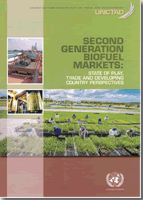Second-generation biofuel markets: state of play, trade and Developing Country perspectives
 UNCTAD's first report on the state of biofuel technologies in 2007 highlighted a sector with great potential, but at the time that was a long way off from markets. In 2015, countries made commitments toward a more environmentally balanced future through the Sustainable Development Goals (SDGs), and now seek to expand policies for low-carbon development after the agreement reached in Paris at COP21. The year also marked a milestone in the bioeconomy, as the point in time when the production of second-generation biofuels (2G) finally took off at commercial scale. Developing countries now face a new set of market opportunities and policy dilemmas to enhance their usage of biomass, which can now be transformed into more valuable products. This report focuses on how these market opportunities can be capitalized on and how to promote technology transfer for developing countries interested in engaging in advanced biofuel markets for the attainment of the SDGs, and as an instrument to meet their commitments under COP21. By carrying out a non-exhaustive mapping of cellulosic ethanol projects and recent policy lessons around the globe, this report seeks to provide public and private practitioners with a macro-picture of the advanced biofuels sector, with a specific focus on cellulosic ethanol as of 2015-2016.
UNCTAD's first report on the state of biofuel technologies in 2007 highlighted a sector with great potential, but at the time that was a long way off from markets. In 2015, countries made commitments toward a more environmentally balanced future through the Sustainable Development Goals (SDGs), and now seek to expand policies for low-carbon development after the agreement reached in Paris at COP21. The year also marked a milestone in the bioeconomy, as the point in time when the production of second-generation biofuels (2G) finally took off at commercial scale. Developing countries now face a new set of market opportunities and policy dilemmas to enhance their usage of biomass, which can now be transformed into more valuable products. This report focuses on how these market opportunities can be capitalized on and how to promote technology transfer for developing countries interested in engaging in advanced biofuel markets for the attainment of the SDGs, and as an instrument to meet their commitments under COP21. By carrying out a non-exhaustive mapping of cellulosic ethanol projects and recent policy lessons around the globe, this report seeks to provide public and private practitioners with a macro-picture of the advanced biofuels sector, with a specific focus on cellulosic ethanol as of 2015-2016.
